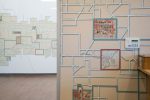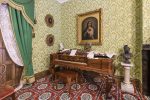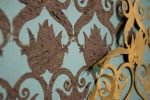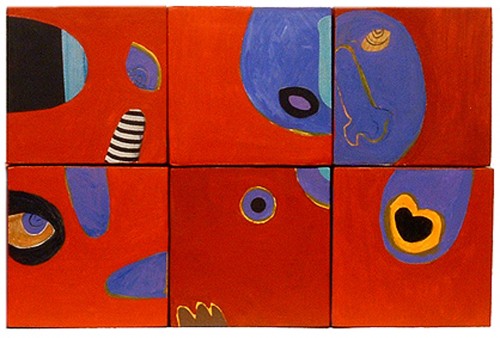Warren Muller and RJ Thornburg’s bahdeebahdu gallery provides an intricate and sumptuous setting for art and the recent exhibition Emergence takes full advantage of it. Curated by Brooke Hine , the show combines clay, fiber, and print works in a move that takes advantage of the many recent conferences that have raced through town leaving a number of exhibits in their wakes.
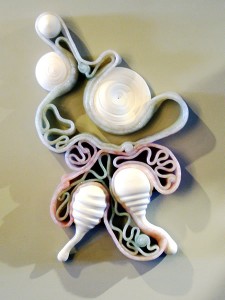
The variety of work interspersed with the light sculptures and other artworks that are fixtures of the space makes the show into a sort of treasure hunt, enticing the viewer to examine every nook and cranny for another surprising piece. And that careful viewer is rewarded with wall paper printed with giant ants, tapestries that play eerie night music, and family photos that, on closer inspection, are inundated with insect life.
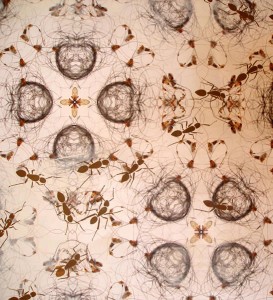
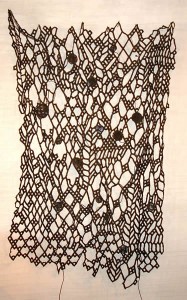
The sculptures and prints cover a lot of ground from semi-whimsical houses atop landscapes of bones, a series of soft fabric sculptures that billow up like candy smoke signals, to contemplative prints that reveal layers of intricate images and drawing on close inspection. It was great to see quiet prints and cut paper pieces hold their own against the more immediate like Casey McDonough’s Conspicuous Absence.
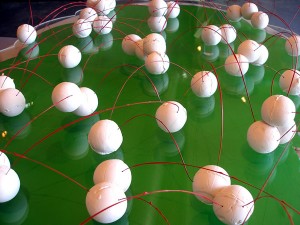
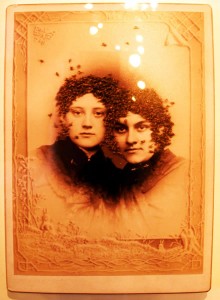
Another advantage of the space was the enticement to move slowly, to relax into the setting. I have been to a number of openings lately, but have rarely seen so many viewers lingering over the work, investigating, revisiting and really looking at what they ostensibly came to see. Something about the environment and the arrangement led people to stay longer and spend more time with the art itself. I’ve often heard that no one looks at art at the opening, and while that is an obvious exaggeration, there is some truth to it. In this case it was refreshing to see so many poring over the work, bringing their companions back and forth to discuss some accent or nuance previously overlooked.
Credit must be given in large part to curator Brooke Hine who brought together such a varied and rich collection of work. The pieces played together like distant cousins at a family reunion, some outgoing, others shy, many with a surface silliness and hidden depths. The show’s title, Emergence, was telling as much of the work revealed itself over time – and the hominess of the location gave viewers the opportunity to take that time.
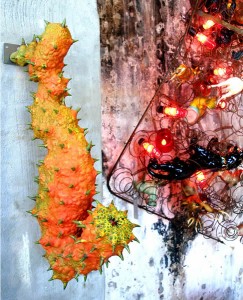
Prints, prints, and prints
On view at schmidt dean gallery are three shows of works on paper – Randy Bolton, Dean Dass, and a collection of master prints. It is a satisfyingly diverse show with contemporary humor, lyrical abstraction, and great imagery and technique. Randy Bolton’s show occupies the front room and for work that mimics the style of old Dick and Jane books it is quite in your face. The pieces seem to be following a particular narrative which my friend and I tried to suss out as we walked around the room. Starting with the show’s title, Yes We Can, and the first print, Lost Horizons, we were thinking this might be a before and after regarding the current administration. A number of pieces seem to be illustrating the tough reality behind the ideal of hope.
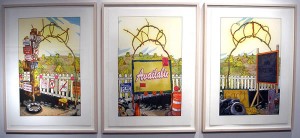
Bolton’s work lines the walls and is all the same size (30”x22”) but for two pieces – Wheat Field and Hard Lessons. These larger pieces are digital banner prints that incorporate sculptural elements. Wheat Field’s subject of two children discovering a skull is echoed by a wooden skull on the floor in front of the work. The real wooden skull looks more fake than the cartoon one which is eerie despite the heavy outlines and half tone style. This banner is held up by white leather tabs that reminded me of paper doll tabs as though there were another image on the reverse.
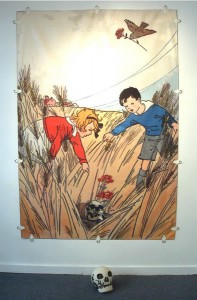
As for the narrative, our interpretation started to break down after the first half a dozen pieces. The large central installation was rich with narrative and political imagery—heavy words like ‘truth’ and ‘hope’ written on old school slates tossed in a field, a goat in a dunce cap covering its eyes, dead trees, spring flowers, a turtle trying to educate the goat—as well as 3-D versions of some of the objects in the print. But in a piece that seems to be trying so hard to educate the viewer, the message is hard to decipher. Little things like pieces of chalk on the ground that actually looked like discarded cigarettes were intriguing, but mystifying.
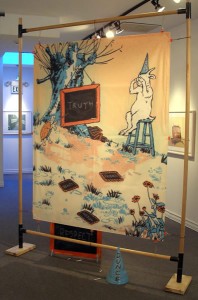
As we walked the room my friend came upon what we would realize later is the last piece and read it aloud “You’re halfway there?! Where does it even start?” With all of the text and educational imagery the work pushes the viewer to puzzle out a specific message or story. But that kind of analysis just leads to an endless series of questions. Our experience improved once we stopped trying to take it all so literally.
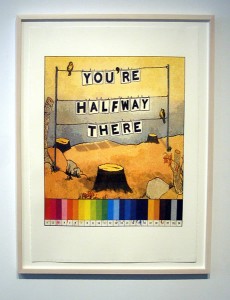
The works in Dean Dass’ Clouds share little with Bolton’s—they have no text, few recognizable images, and no snappy titles. In fact they provide a great non-verbal counterpoint to the accompanying shows. Dass tried to describe these cloud forms in a short video available on the schmidt dean website. He likes to “tease the edge of formlessness” out in his pieces. The runny results are like pale ink blots—they don’t so much look like clouds as mimic a cloud’s ability to let you see whatever forms you like in the undulating shadows. In contrast to both Bolton and the master works in the back room, Dass eschews heavy line in favor of bleed. The paper seems impregnated with color rather than having an image impressed on the surface. It is a wholly different approach to print. With the three shows schmidt dean provides a substantial range of possibilities on paper. There is a strong selection of pieces in the master prints show as well—too many to mention here.
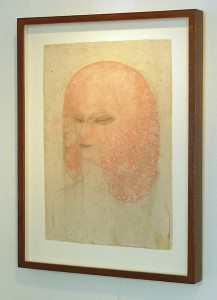
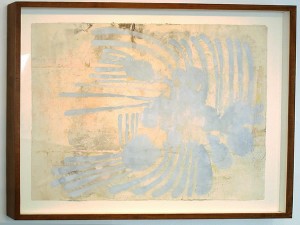
Randy Bolton, Dean Dass and Master Prints are showing at schmidt dean gallery March 19- Apr 24, 2010.


